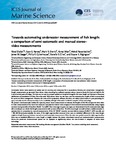Towards automating underwater measurement of fish length: a comparison of semi-automatic and manual stereo–video measurements
| dc.contributor.author | Shafait F, Harvey ES, Shortis MR, Mian A, Ravanbakhsh, M, Seager JW, Culverhouse PF, Cline DE, and Edgington DR, | |
| dc.date.accessioned | 2017-03-01T08:48:59Z | |
| dc.date.available | 2017-03-01T08:48:59Z | |
| dc.date.issued | 2017-02-27 | |
| dc.identifier.issn | 1054-3139 | |
| dc.identifier.issn | 1095-9289 | |
| dc.identifier.uri | http://hdl.handle.net/10026.1/8570 | |
| dc.description.abstract |
Underwater stereo–video systems are widely used for counting and measuring fish in aquaculture, fisheries, and conservation management. Length measurements are generated from stereo–video recordings by a software operator using a mouse to locate the head and tail of a fish in synchronized pairs of images. This data can be used to compare spatial and temporal changes in the mean length and biomass or frequency distributions of populations of fishes. Since the early 1990s stereo–video has also been used for measuring the lengths of fish in aquaculture for quota and farm management. However, the costs of the equipment, software, the time, and salary costs involved in post processing imagery manually and the subsequent delays in the availability of length information inhibit the adoption of this technology. We present a semi-automatic method for capturing stereo–video measurements to estimate the lengths of fish. We compare the time taken to make measurements of the same fish measured manually from stereo–video imagery to that measured semi-automatically. Using imagery recorded during transfers of Southern Bluefin Tuna (SBT) from tow cages to grow out cages, we demonstrate that the semi-automatic algorithm developed can obtain fork length measurements with an error of less than 1% of the true length and with at least a sixfold reduction in operator time in comparison to manual measurements. Of the 22 138 SBT recorded we were able to measure 52.6% (11 647) manually and 11.8% (2614) semi-automatically. For seven of the eight cage transfers recorde,d there were no statistical differences in the mean length, weight, or length frequency between manual and semi-automatic measurements. When the data were pooled across the eight cage transfers, there was no statistical difference in mean length or weight between the stereo–video-based manual and semi-automated measurements. Hence, the presented semi-automatic system can be deployed to significantly reduce the cost involved in adoption of stereo–video technology. | |
| dc.format.extent | 1690-1701 | |
| dc.language | en | |
| dc.language.iso | en | |
| dc.publisher | Oxford University Press (OUP) | |
| dc.subject | automated measurement | |
| dc.subject | fish tracking | |
| dc.subject | fisheries management | |
| dc.subject | Southern Bluefin Tuna | |
| dc.subject | stereo matching | |
| dc.subject | stock assessment | |
| dc.subject | underwater stereo-video | |
| dc.subject | video sequences | |
| dc.title | Towards automating underwater measurement of fish length: a comparison of semi-automatic and manual stereo–video measurements | |
| dc.type | journal-article | |
| dc.type | Journal Article | |
| plymouth.author-url | https://www.webofscience.com/api/gateway?GWVersion=2&SrcApp=PARTNER_APP&SrcAuth=LinksAMR&KeyUT=WOS:000406598500020&DestLinkType=FullRecord&DestApp=ALL_WOS&UsrCustomerID=11bb513d99f797142bcfeffcc58ea008 | |
| plymouth.issue | 6 | |
| plymouth.volume | 74 | |
| plymouth.publication-status | Published online | |
| plymouth.journal | ICES Journal of Marine Science | |
| dc.identifier.doi | 10.1093/icesjms/fsx007 | |
| plymouth.organisational-group | /Plymouth | |
| plymouth.organisational-group | /Plymouth/Faculty of Science and Engineering | |
| plymouth.organisational-group | /Plymouth/Research Groups | |
| plymouth.organisational-group | /Plymouth/Research Groups/Marine Institute | |
| dcterms.dateAccepted | 2016-12-14 | |
| dc.rights.embargodate | 2018-2-27 | |
| dc.identifier.eissn | 1095-9289 | |
| dc.rights.embargoperiod | Not known | |
| rioxxterms.versionofrecord | 10.1093/icesjms/fsx007 | |
| rioxxterms.licenseref.uri | http://www.rioxx.net/licenses/all-rights-reserved | |
| rioxxterms.licenseref.startdate | 2017-02-27 | |
| rioxxterms.type | Journal Article/Review |


